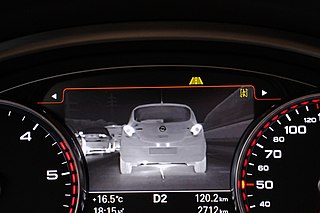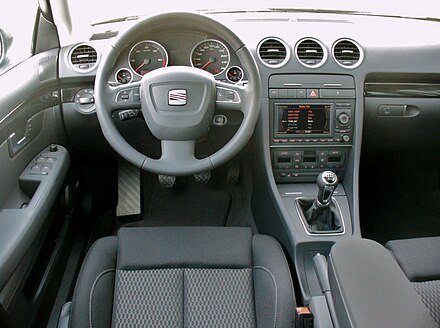IRIVER is a South Korean consumer electronics company and is widely known for its digital audio players and other portable media devices. The company is a brand and marketing division of iriver Inc, a South Korean electronics and entertainment company founded in 1999 by seven former Samsung executives.
iDrive is an in-car communications and entertainment system made by BMW, used to control most secondary vehicle systems in late-model BMW cars. It was launched in 2001, first appearing in the E65 7 Series. The system unifies an array of functions under a single control architecture consisting of an LCD panel mounted in the dashboard and a control knob mounted on the center console.
ZEN refers to the series of portable media player designed and manufactured by Creative Technology Limited, the names of which start with the word ZEN, e.g. ZEN, ZEN X-Fi. The players evolved from the NOMAD brand through the NOMAD Jukebox series. Three of Creative Technology's players won the Best of CES award from 2004 to 2006 in their respective categories, with one winning the overall award. The ZEN series has a strong foothold in Asian markets, especially in Singapore, the company's headquarters.

An automotive navigation system is part of the automobile controls or a third party add-on used to find direction in an automobile. It typically uses a satellite navigation device to get its position data which is then correlated to a position on a road. When directions are needed routing can be calculated. On the fly traffic information can be used to adjust the route.

The Audi RS 4 is the high-performance variant of the Audi A4 range produced by Audi Sport GmbH, for AUDI AG, a division of the Volkswagen Group. It slots distinctly above the Audi S4, as the fastest, most sports-focused car based on the A4's "B" automobile platform. The RS 4 made a return in 2012, in Avant form based on the A4 Avant.

Moxi was a line of high definition digital video recorders produced by Moxi Digital, Digeo, and then Arris Group. Moxi was originally released only to cable operators, but in December 2008 was released as a retail product, and removed from the market November 2011. The former retail product, the Moxi HD DVR, provides a high definition user interface with support for either two or three CableCARD TV tuners. Arris also offered a companion appliance, the Moxi Mate, which can stream live or recorded TV from a Moxi HD DVR.
Alpine Electronics, Inc. is the consumer electronics subsidiary of the Japanese electronics component manufacturer Alps Electric, specializing in car audio and navigation systems.

Digital signage is a sub-segment of electronic signage. Digital displays use technologies such as LCD, LED, projection and e-paper to display digital images, video, web pages, weather data, restaurant menus, or text. They can be found in public spaces, transportation systems, museums, stadiums, retail stores, hotels, restaurants and corporate buildings etc., to provide wayfinding, exhibitions, marketing and outdoor advertising. They are used as a network of electronic displays that are centrally managed and individually addressable for the display of text, animated or video messages for advertising, information, entertainment and merchandising to targeted audiences.

Windows Media Center (WMC) is a discontinued digital video recorder and media player created by Microsoft. Media Center was first introduced to Windows in 2002 on Windows XP Media Center Edition (MCE). It was included in Home Premium and Ultimate editions of Windows Vista, as well as all editions of Windows 7 except Starter and Home Basic. It was also available on Windows 8 Pro and Windows 8.1 Pro as a paid add-on, before being discontinued in Windows 10, although it can reportedly be unofficially reinstalled using a series of Command Prompt commands.

Cockpit Management and Data system - COMAND for short - acts as a combined command and control centre for all audio, telematics and telecommunications functions on Mercedes-Benz vehicles and includes a dedicated flat display screen. In addition to the GPS navigation system and general processing and control logic, COMAND includes components such as an address book, telephone, radio and in many cases a CD/DVD drive. It is connected to other devices such as CD/DVD changers, sound system and surround sound amplifier, TV receiver and the optional Linguatronic voice control system via an optical fibre network. The first generations of COMAND used the D2B optical network standard whereas later models are based on MOST.

Yepp was Samsung Electronics' digital audio player brand until Samsung decided to retire most of their family brands in February 2011. From then on, their MP3 players were simply branded "Samsung" worldwide until they discontinued all of them late 2013. The brand included a wide range of hard-drive based as well as flash-memory based players. The name is claimed to be an acronym for "young, energetic, passionate person".
The Gigabeat was a line of digital media players by Toshiba.

The Multi Media Interface (MMI) system is an in-car user interface media system developed by Audi, and was launched at the 2001 Frankfurt Motor Show on the Audi Avantissimo concept car. Production MMI was introduced in the second generation Audi A8 D3 in late 2002 and implemented in majority of its latest series of automobiles.

The SEAT Exeo is a large family car and flagship model, that was built by the Spanish car manufacturer SEAT, subsidiary of the Volkswagen Group.

The Samsung SGH-i900, also known as Omnia I or WiTu, is a smartphone created by Samsung Mobile. Announced in June 2008, the Omnia was launched in Singapore in mid-June, available in stores on the 20th of June, and in the rest of Asia in July. For some parts of Europe, it was launched in August. The American version launched in December 2008 through Verizon Wireless while the Canadian version launched in April 2009 through Telus Mobility.

Remote Touch is a vehicle interface system present in some Lexus cars for use in conjunction with in-car information, configuration, and entertainment systems. The Remote Touch controller, which is similar to a computer mouse or joystick, allows the driver to operate an on-screen cursor on the vehicle's GPS navigation system screen.

An automotive night vision system uses a thermographic camera to increase a driver's perception and seeing distance in darkness or poor weather beyond the reach of the vehicle's headlights. Such systems are offered as optional equipment on certain premium vehicles. The technology was first introduced in the year 2000 on the Cadillac Deville. This technology is based on the night vision devices (NVD), which generally denotes any electronically enhanced optical devices operate in three modes: image enhancement, thermal imaging, and active illumination. The automotive night vision system is a combination of NVDs such as infrared cameras, GPS, Lidar, and Radar, among others to sense and detect objects.

MyFord Touch is an in-car communications and entertainment system developed by the Ford Motor Company, based on Microsoft technologies. The technology was factory installed with Ford product offerings and was based on the Microsoft Auto 4.0 software platform. It was regarded as the next-generation of Ford Sync. Announced in January 2010, at the Consumer Electronics Show (CES), the technology launched with the 2011 Ford Edge. Reviews of MyFord Touch were overwhelmingly negative. A USB drive, self-installed software upgrade became available in March, 2012; this update was mailed out free-of-charge to all Ford customers, and Ford also offered free installation of the update by any Ford dealer. The update did not address continuing problems with light-touch capacitor switches that control many functions. Several updates have since been released which allowed for more natural speech recognition, simpler Bluetooth pairing, and refinement of the on-screen interface and menus.
MyLink a.k.a. Intellilink is a telematics system/infotainment system offered by General Motors in their vehicles. The system was debuted in 2011 in the then-new Chevrolet Volt plug-in hybrid car.

Android Auto is a mobile app developed by Google to mirror features from an Android device, such as a smartphone, to a car's compatible in-dash information and entertainment head unit.

















